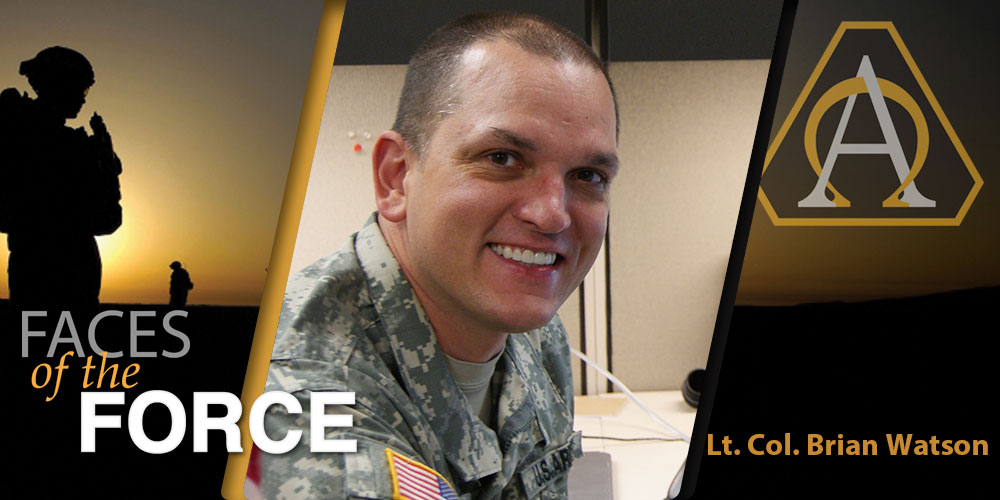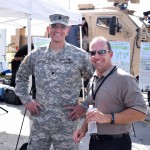
POSITION AND UNIT: Chief of Platform Integration, Program Executive Office for Combat Support and Combat Service Support
YEARS OF SERVICE IN WORKFORCE: 8
YEARS OF MILITARY SERVICE: 18
DAWIA CERTIFICATIONS: Level III in program management; Level I in contracting
EDUCATION: MBA, Colorado State University; B.S. in geology, Washington State University
AWARDS: Bronze Star Medal; Meritorious Service Medal; Army Commendation Medal (4 Oak Leaf Clusters); Parachutist Badge; Department of the Army Staff Badge
Leveraging TARDEC’s ‘50-Pound Brains’
By Susan L. Follett
Lt. Col. Brian Watson admits that, early in his development as a program manager, he didn’t devote a lot of attention to systems engineering. But that changed two years ago, when he became chief of platform integration for Program Executive Office for Combat Support and Combat Service Support (PEO CS&CSS).
“Being located on the TACOM campus, I’ve been fortunate to work very closely with one of our stakeholder organizations, the Tank Automotive Research Development and Engineering Center (TARDEC). The engineers there have 50-pound brains: they’re absolute wizards at systems engineering, very passionate about their work and quick to help people like me understand their craft,” he said.
“I can’t hope to achieve their level of expertise,” he added. “But I now have a much better understanding of how systems engineering results in weapon systems that are aligned to our warfighters’ needs. It’s important that acquisition professionals reach out to partner organizations to understand how they fit into the overall acquisition of systems.”
Watson’s career has included a brief stint as a stockbroker sandwiched between five years of active duty Army service and his current active duty assignment with the Army National Guard (ARNG). He’s quick to mention the impact mentors have had on his career, most recently Col. John Cavedo, the former joint program manager for the Joint Light Tactical Vehicle Program. “He helped me get to this position, and he saw that it would be a good move for me. Over the years, I’ve been fortunate to have a number of other mentors—too many to mention, really. However, through it all, my family has been my bedrock and motivation to excel in this career field. For that, I cannot thank them enough—along with all my mentors, past and present—for their counsel, support and faith in my abilities.”

Lt. Col. Brian Watson poses with John Hufstedler, deputy chief for Platform Integration at the PEO CS&CSS, during the VICTORY demonstration at the Modern Day Marine Exposition. (All photos by Jaspal Brar, Marine Corps Systems Command.)
What do you do, and why is it important to the Army or the warfighter?
I am the principal staff officer responsible for the integration of command, control, communications, computers, intelligence, surveillance and reconnaissance and electronic warfare (C4ISR/EW) equipment onto Tactical Wheeled Vehicle (TWV) platforms. I coordinate the execution of capability set integration and Network Integration Evaluations (NIE). I also coordinate the convergence of C4ISR/EW systems and TWV platforms onto the common, scalable electronic architecture known as VICTORY, or the Vehicular Integration for C4ISR/EW (command, control, communications, computers, intelligence, surveillance and reconnaissance – electronic warfare) Interoperability. I facilitate the network integration activities of multiple project offices within the TWV portfolio, including the light, medium and heavy TWV, the Joint Light Tactical Vehicle (JLTV) and Mine Resistant Ambush Protected (MRAP) vehicles.
With our VICTORY initiative, we are demonstrating how adopting an integration method that relies on open, common standards could increase situational awareness within vehicles and across unit formations. This effort gives Soldiers a common set of tools and results in expanded capabilities with fewer hardware items, all while allowing the Army to reduce Soldiers’ operational burdens and providing better insight into logistics and maintenance.
One of the most visible aspects of VICTORY is that it really optimizes the space available within vehicles while at the same time providing significantly more capability, such as remote radio control and passing imagery obtained from weapon systems to other vehicles in a formation. Soldiers and Marines have remarked at how much less cluttered and congested the interiors of VICTORY-enabled TWVs are as compared to previous versions. By moving items out of the vehicle cab and more efficiently using that space, we’re also increasing the safety of the crew: they no longer need to climb over or around equipment to egress the vehicle in emergencies.
Our initial feedback from NIE 15.2 has been resoundingly positive, from Soldiers and Army senior leaders alike. As a result of this feedback, we’ve decided to continue maturing our concepts at future NIEs in the hopes of receiving additional input and ultimately receiving an affirmative fielding recommendation. I hope that around the 2019 or 2020 timeframe, we will begin equipping all of our TWVs with a low-cost solution that gets us as close as possible to a “plug and play” architecture for hardware and software integration.

Lt. Col. Brian Watson and Nathan Clark, director of Ground Combat System and Vehicle Technical Services for Control Point Corp., were among the representatives from the joint VICTORY team that took part in the Modern Day Marine Exposition at Marine Corps Base Quantico.
How did you become part of the Army Acquisition Workforce?
I have been an acquisition officer since 2007, when I joined the ARNG’s Materiel Programs Division as a financial and equipment resources analyst. I spent several years in that capacity, tackling issues such as increasing the transparency by which ARNG equipment shortfalls were determined and minimized through the fielding of modern equipment.
In 2011, I became one of the first officers of the ARNG’s newly formed acquisition workforce to assume duties within the Army’s AL&T workforce. Since then, I have broadened my experience as an acquisition officer by serving as an assistant program manager on the JLTV program, and more recently in my current position in charge of network integration onto TWV platforms.
What do you see as the most important points in your career with the Army Acquisition Workforce, and why? Is there a program or opportunity you wish you had pursued but didn’t?
I am very happy with where I am in my career, and I owe that fact to my professional mentors who drilled into me one of my guiding principles: Seek the hard jobs that not everybody necessarily wants. Those jobs may not be glamorous, or have the most exposure, but they’re important to the Army and need to get done. Then, while you’re in that job, one of your goals should be to establish processes and find efficiencies so that by the time you leave, your position isn’t as critical as it was on day one. So, while there may have been many opportunities I did not pursue, I am very satisfied with the choices I’ve made that have gotten me to this point.

The joint Army and Marine Corps VICTORY team includes representatives from PEO CS&CSS, TARDEC, Marine Corps Systems Command, Agile Communications, Southwest Research Institute, DCS Corp. and Control Point Corp.
What’s the greatest satisfaction you have in being a part of the Army Acquisition Workforce?
I have good friends currently in positions of leadership within the Army’s operating forces. It’s been highly rewarding to be able to call them and ask them if I’m delivering the integrated capabilities they require. It’s a great feeling to know that your efforts directly fill the needs of Soldiers who are about to head into harm’s way.
What’s something that most people don’t know about your job?
I like to say that I have all the responsibility to integrate the network onto TWVs but none of the authority. Our platform PMs have that authority, so I’ve had to really expand my ability to build coalitions with the goal of delivering integrated vehicles. As a person who’s used to more direct leadership methods, I cannot overstate how important it has been to develop techniques that convey the value of coordinated approaches to vehicular integration and establish teams oriented to delivering integrated platforms within very challenging timelines.

Soldiers, Marines and civilians attend the Modern Day Marine Exposition at Marine Corps Base Quantico on Sept. 22-24. Lt. Col. Brian Watson and his joint Army and Marine Corps team used the event to showcase the implementation of VICTORY on an MRAP all-terrain vehicle.
“Faces of the Force” is an online series highlighting members of the Army Acquisition Workforce through the power of individual stories. Profiles are produced by the U.S. Army Acquisition Support Center Communication and Support Branch, working closely with public affairs officers to feature Soldiers and Civilians currently serving in a variety of AL&T disciplines. For more information, or to nominate someone, please contact 703-805-1006.
Subscribe to Army AL&T News is the premier online news source for the Acquisition, Logistics, and Technology (AL&T) Workforce.
![]() Subscribe
Subscribe







